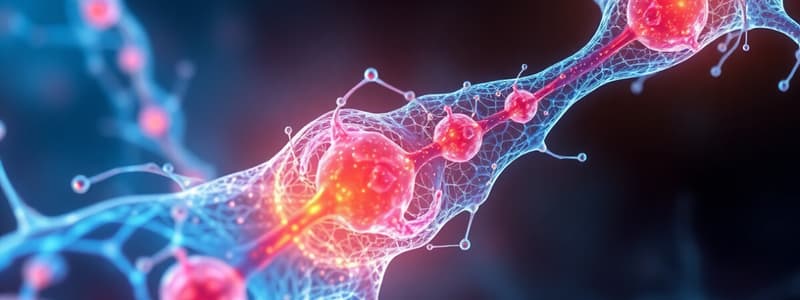Podcast
Questions and Answers
What is the primary role of connective tissue?
What is the primary role of connective tissue?
- Protection against pathogens
- Maintain the form of the body and its organs (correct)
- Facilitate cellular communication
- Store essential nutrients
Which type of cells is NOT typically found in connective tissue?
Which type of cells is NOT typically found in connective tissue?
- Macrophages
- Fibroblasts
- Neurons (correct)
- Adipocytes
What does the extracellular matrix of connective tissue primarily consist of?
What does the extracellular matrix of connective tissue primarily consist of?
- Glycoproteins, fibrous proteins, and glycosaminoglycans (correct)
- Epithelial cells and water
- Muscle fibers and ionic compounds
- Nerve processes and lymphatic fluid
Which of the following types of connective tissue is specialized for metabolic maintenance?
Which of the following types of connective tissue is specialized for metabolic maintenance?
How are connective tissues primarily classified?
How are connective tissues primarily classified?
Which type of loose connective tissue is primarily involved in energy storage and thermal insulation?
Which type of loose connective tissue is primarily involved in energy storage and thermal insulation?
What type of cells are primarily found in cartilage?
What type of cells are primarily found in cartilage?
Which of the following is NOT classified as a type of connective tissue proper?
Which of the following is NOT classified as a type of connective tissue proper?
Which connective tissue type is known for forming the structural framework of organs like lymph nodes?
Which connective tissue type is known for forming the structural framework of organs like lymph nodes?
What is the primary feature of dense regular connective tissue?
What is the primary feature of dense regular connective tissue?
Which type of fluid connective tissue contains erythrocytes, leukocytes, and platelets?
Which type of fluid connective tissue contains erythrocytes, leukocytes, and platelets?
Which type of connective tissue is specialized for shock absorption?
Which type of connective tissue is specialized for shock absorption?
What is a characteristic feature of reticular connective tissue?
What is a characteristic feature of reticular connective tissue?
Which type of connective tissue is characterized by its loose fibres and numerous cells?
Which type of connective tissue is characterized by its loose fibres and numerous cells?
What is the primary role of the extracellular matrix in connective tissues?
What is the primary role of the extracellular matrix in connective tissues?
Which type of cell is not classified as a transient cell in connective tissues?
Which type of cell is not classified as a transient cell in connective tissues?
Which of the following is NOT a type of connective tissue fibre?
Which of the following is NOT a type of connective tissue fibre?
What constitutes the non-cellular substrate of connective tissue?
What constitutes the non-cellular substrate of connective tissue?
Which classification of connective tissue is characterized by a supportive network for cells?
Which classification of connective tissue is characterized by a supportive network for cells?
What type of connective tissue is characterized by being found in most areas of the human body?
What type of connective tissue is characterized by being found in most areas of the human body?
Which of the following best describes the characteristics of fibroblasts?
Which of the following best describes the characteristics of fibroblasts?
Flashcards are hidden until you start studying
Study Notes
Overview of Connective Tissue
- Connective tissue supports body structure and organs, providing cohesion and internal stability.
- Varies in density, cellularity, and specialization among types.
Components of Connective Tissue
- Composed of water, cells (e.g., fibroblasts, adipocytes, macrophages), and an extracellular matrix.
- Extracellular matrix consists of glycoproteins, fibrous proteins, and glycosaminoglycans (GAGs).
Cells of Connective Tissue
- Fixed cells include:
- Fibroblasts
- Adipocytes
- Macrophages
- Mast cells
- Transient cells include:
- Plasma cells
- Eosinophils
Extracellular Matrix
- Known as ground substance; an amorphous, gelatinous, and transparent material.
- Fills spaces between cells and fibers, facilitating transportation of metabolites.
- Composed of GAGs that form proteoglycans, which help resist compression.
Types of Fibers
- Fibers secreted by fibroblasts create a supporting network for cells.
- Three main types of fibers:
- Elastic fibers
- Collagen fibers
- Reticular fibers
Classification of Connective Tissue
- Connective Tissue Proper:
- Loose connective tissue
- Dense connective tissue (regular and irregular)
- Specialized Connective Tissue:
- Supporting connective tissue (cartilage, bone)
- Fluid connective tissue (blood, lymph)
Loose Connective Tissue
- Contains numerous cells and loose fibers, aiding in support and connection of other tissues.
- Types include:
- Areolar: Covers muscle fibers, present in skin and mucous membranes.
- Adipose: Acts as insulation and energy store, comprises white adipose tissue.
- Reticular: Contains reticular cells, found in lymph nodes.
Dense Connective Tissue
- Characterized by thick fibers and a slightly viscous fluid.
- Types include:
- Dense Regular: Fibers arranged parallel for strength.
- Dense Irregular: Fibers arranged randomly for multi-directional strength.
Specialized Connective Tissues
- Cartilage:
- Coarser than other connective tissues, populated with chondrocytes.
- Types include hyaline, fibrocartilage, and elastic cartilage.
- Bone:
- Divided into compact and spongy bone types.
Blood
- Composed of plasma, a specialized fluid, with circulating blood cells (erythrocytes, leucocytes, platelets).
Learning Outcomes
- Ability to state functions and characteristics of connective tissue.
- Knowledge of non-cellular substrates, cell types, and fiber classifications in connective tissue.
- Understanding of connective tissue types and their organization in the human body.
Studying That Suits You
Use AI to generate personalized quizzes and flashcards to suit your learning preferences.



